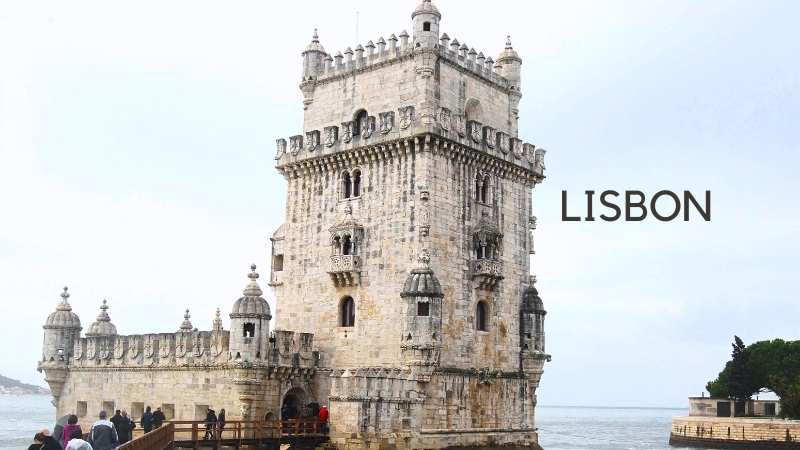Edmonton
My European Favourites – Lisbon’s Belem District


The Belem district of Lisbon is where you will find the most famous buildings and monuments from what is called the Age of Exploration or Age of Discovery as well as numerous parks and museums. It is located along the coast at the mouth of the Tagus river about 4 kilometers west of Lisbon’s city center. Belem, which is Bethlehem in Portuguese, used to be a small fishing village before it became the shipyard and docks at the center of the discoveries. It remained a separate town until recently when it became a parish district of the city of Lisbon. To better understand the Belem district and its monuments requires a brief history of the Age of Discovery, Prince Henry the Navigator and the Order of Christ.
In the 15th and 16th centuries, Portuguese sailors were at the forefront of the Age of Discovery. They recorded information about places they visited, and they mapped the coasts of Africa, Asia, Brazil and even Newfoundland. The expeditions were started in 1419 along the west coast of Africa under the sponsorship of Prince Henry the Navigator, who at the time, was Grand Master of the Order of Christ.

Historical figures from the Age of Discovery on the Monument of the Discoveries
The Order of Christ’s origins in Portugal lie with the Knights Templar that were founded around 1119. The Templars were best known as Christian warriors, but the majority of their membership were not combatants; they managed the economies in Europe and formed an early form of banking and finance. The Templars, who had become wealthy and powerful, were abolished on the 22nd of March 1312 by Pope Clement V under pressure from the French King Philip IV. The French king had many debts with the Templars, so he was motivated by an opportunity to erase those debts and remove the Templar threat to his power and influence.
The Templars were pursued, persecuted and annihilated throughout Europe with the help of political influence from the Pope as head of the Catholic Church. Portugal’s King Denis refused to go after the Templars and in 1319, he negotiated with Clement’s successor, Pope John XXII, to establish the Order of Christ, which were granted the right to inherit the assets and property of the Templars. So, with the support of the order’s Grand Master, Prince Henry, the emblematic cross of the Order of Christ was emblazoned on Portuguese sails during the discoveries.
The cross is seen on various emblems today including on the logo of the Portuguese national soccer team and on that of the Brazilian national soccer team. If you are interested in the Knights Templar and Order of Christ, there are various sites of interest throughout Portugal.

Compass Rose with a World Map of Portuguese explorations
To conduct the exploration of northern Africa, the Portuguese needed a vessel that could be easily maneuvered, so they developed a small boat called a caravel. The caravel had lateen sails, so it could reach good speed on the open water with the wind at its back, but just as important, it could also be sailed into the wind. Using the caravel, the Portuguese worked their way along the African coast and set up trade posts.
Eventually, in 1488, Bartolomeu Dias reached the Cape of Good Hope and rounded the southern tip of Africa and into the Pacific Ocean. Probably the most famous Portuguese discoverer, Vasco da Gama, followed the same path and reached India in 1498 setting up the spice trading route. By cutting out the “middle men,” which at that time were Arab, Turkish and Italian merchants, the Portuguese Crown became very wealthy.
In 1500, Pedro Alvares Cabral set sail for India but sailed far west into the Atlantic to take advantage of the trade winds. He spotted the northeastern part of South America which would become a Portuguese colony and the only Portuguese speaking country in the Americas, Brazil.
The Portuguese continued setting up trade routes to other parts of Asia, including Japan in 1542. The immense wealth from the discoveries and subsequent trade laid the foundation for the Portuguese Empire.

Manueline style architecture, a caravel and the Order of Christ cross on the Portuguese national soccer team logo
With wealth, came great building projects. Portugal has a unique architectural style called Manueline or sometimes referred to as Portuguese late Gothic. The Manueline style originated during the 16th century and depicts maritime elements paying tribute to the discoveries made at that time and financed by the resulting lucrative spice trade. Some of the most prominent features of the Manueline style include armillary spheres, sea shells, the cross of the Order of Christ, rope columns and botanical motifs like laurel branches, oak leaves and acorns. Many Manueline buildings were destroyed in the great earthquake in 1755, but the Tower of Belem and Hieronymites Monastery, which are UNESCO World Heritage Sites, are two of the best examples we can see today.

Belem Tower wall, view of the Tower from the Discoveries Monument and the Santa Cruz sea biplane
The Belem Tower, officially named the Tower of St. Vincent, is a four story 16th century fortification that guarded the entrance into Lisbon. It was the last and first thing explorers saw as they left and returned from their voyages. When it was first built in 1520, the tower stood on an island in the middle of the Tagus river, about 200 meters from the northern shore. The tower has been rebuilt various times and its current style combines Manueline, Gothic, Moorish and Renaissance features. It has also been used as a prison and is one of the most recognizable and photographed landmarks of Lisbon and Portugal. For a fee, you can enter the tower.
At the corner of the Belem Tower Park, you will see the Santa Cruz biplane monument dedicated to Gago Coutinho and Sacadura Cabral who were the first pilots to cross the South Atlantic ocean in 1922. The seaplane was followed by a support ship as they didn’t have the fuel capacity to make the entire voyage. It was a perilous 79 day journey from Lisbon to Rio de Janeiro, and the plane was ditched along the Brazil coast after an engine failure in bad weather. It’s quite the story. You can see a replica of the actual plane in the Maritime Museum. From the monument walk around the Bom Sucessso docks and along a nice waterfront walkway. You will pass the Old Belem Lighthouse on the way to our next stop, the Monument of the Discoveries.

Monument of the Discoveries, Compase Rose and Prince Henry the Navigator
The 52 meter Monument of the Discoveries (Padrão dos Descobrimentos), completed in 1960, celebrates the Age of Discovery and is designed to look like a caravel. The monument commemorates the 500th anniversary of the death of Prince Henry the Navigator, depicted at the front of the monument holding a caravel. The monument has sixteen statues on each side of Prince Henry depicting notable people from that era including monarchs, explorers, cartographers, artists, poets, scientists, and missionaries. The square in front of the monument, donated by South Africa, has a compass rose and a world map detailing the Portuguese explorations. Inside, there are exhibition halls and an auditorium plus a lift to the top of the monument that offers great views of the Tagus river, the 25th of April Bridge, the statue of Cristo Rei on the other side of the river, the world map on the square below and the Hieronymites Monastery.

Hieronymites Monastery from the Monument of the Discoveries
The Hieronymites Monastery (Mosteiro dos Jeronimos), started by King Manuel I in 1501, and took 100 years to complete, is the former monastery of the Order of Saint Jerome. The monks’ role was to provide spiritual guidance to the sailors and to pray for the king’s soul. In front of the monastery, there is a nice park with hedges and a fountain decorated with the coats of arms.
The Santa Maria de Belem church and the monastery cloisters are great examples of Manueline architecture. The entrance to the church is free while there is a charge to see the monastery cloisters. Once you enter the cloisters, you can enter the vault of the Santa Maria church for a great view of the columns and nave. Some kings and great figures in Portuguese history are buried here including Vasco da Gama, whose tomb you can see at the entrance, along with the poet Luis de Camões, who wrote the epic, “The Lusiads,” detailing the exploits of Gama and his compatriots.

Hieronymites Moanstery fountain, Santa Maria de Belem church interior and the tomb of Vasco da Gama
In the western wing of the Hieronymites Monastery, you will find two museums. The Maritime Museum (Museu da Marinha) is administered by the Navy and offers more details about the explorations and all other aspects of the Portuguese history of navigation. You can see scale models of ships, maps, paintings, navigation instruments, royal barges and sea planes.
The Museu Nacional de Arqueologia (National Museum of Archaeology), founded in 1893, contains ancient art and artifacts from throughout the Iberian Peninsula. In the Belem Cultural Centre, located near the monastery, there is the Coleção Berardo, which is a modern and contemporary art gallery.

The Pastéis de Belém busy counter, a peek at the production and the beautiful tarts
After a busy morning, you might need a snack. The Pastel de Nata is a Portuguese custard tart with a flaky crust that is dusted with cinnamon. It was invented by Catholic monks in Belem at the Hieronymites Monastery before the 18th century. Why the monks, you ask? Convents and monasteries used egg whites in those days to starch clothes, so the leftover yokes were used to make cakes and pastries. Today, the nearby Pastéis de Belém café is a must stop while you are in Belem to taste the authentically made pastry. There are sometimes long line ups outside, but they are customers waiting to buy “to go” sleeves of the treat.
There are many seats inside, in various rooms, where you can sit and order your tarts and coffee. As you go deeper inside, there are windows where you can see the custard tart operation at work. Every few minutes you will see a staff member emerge from the bakery carrying multiple trays of the tarts to restock the front counter as they constantly fly off the shelf. Every self-respecting Portuguese bakery in the world makes their version, but the monks’ original recipe is a closely guarded secret and is held by just a few people. They have all memorized the recipe as there can be no written version.
Just further down the street, you will see the Pink Palace, which is the official residence of the Portuguese President. Next to the palace is the 18th century Royal Riding School, which used to house the Museu Nacional dos Coches (National Coaches Museum). The Royal Riding School can still be visited and will have some coaches on display. The museum’s new location, which is only a few meters away, has a much larger space to show off one of the world’s finest collections of horse drawn carriages the from 16th to the 19th century.
The 5 hectare Jardim Botânico Tropical (Tropical Botanical Garden), which was laid out in 1912 by Hieronymites Monastery, is one of Lisbon’s best green spaces. The park has flora from all over the world, principally from Portugal’s former colonies. Some of the art and architecture with colonial themes date back to the 1940 Portuguese World Exhibition. The grounds have 18th century marble statues by Italian artists, an Arch of Macau, an Oriental garden, greenhouses, and the 17th century baroque Calheta Palace, which is now a library and is used for exhibitions. Visitors enjoy seeing the ducks, swans, geese and peacocks who are found throughout the garden and its ponds. It is a good place to take a break from a busy day in Belem.
In the evening, you may consider a short walk along the waterfront, maybe while enjoying a beautiful sunset, to the Doca de Santo Amaro (Dock of St. Amaro). The dock is located next to the foot of the 25th of April Bridge. Here, you will find a variety of restaurants to have a nice dinner. As you enjoy your wine, you can reflect on the courage of the great explorers who left these shores to explore the world.
Explore Europe With Us
Azorcan Global Sport, School and Sightseeing Tours have taken thousands to Europe on their custom group tours since 1994. Visit azorcan.net to see all our custom tour possibilities for your group of 26 or more. Individuals can join our “open” signature sport, sightseeing and sport fan tours including our popular Canada hockey fan tours to the World Juniors. At azorcan.net/media you can read our newsletters and listen to our podcasts.
Images compliments of Paul Almeida and Azorcan Tours.
Alberta
Male suspect involved in tragic incident between Beaumont and Edmonton sought by police; EPS release photos of suspect

News release from the Edmonton Police Service (EPS)
The Edmonton Police Service (EPS) is assisting the RCMP with the investigation into a tragic incident that claimed the life of an innocent woman last night on 50 Street.
Yesterday, Saturday, Feb. 24, 2024, at approximately 9:40 p.m. various EPS resources were deployed to the area of 50 Street and 22 Avenue SW at the request of the RCMP. It was reported to police that RCMP attempted to conduct a traffic stop on a suspicious U-Haul in Beaumont, when the vehicle fled. The U-Haul subsequently travelled north on 50 Street into Edmonton, where it struck and killed a woman inspecting the exterior of her vehicle. Moments later the U-Haul came to rest just outside a gas station off of 22 Avenue and 50 Street.
After crashing the U-Haul, the male suspect then reportedly stole a Honda Civic that was parked outside the gas station with a child inside. Police did consider an Alert to the public at the time, though thankfully the child was located unharmed in the area of 66 Street and 25 Avenue minutes later. The suspect then fled the scene in the Honda Civic. The stolen vehicle has since been recovered outside of Edmonton.
The EPS and RCMP continue to actively seek the identity and whereabouts of the male suspect described as being approximately 5’11” who was last seen wearing a black hoodie with white text on the front, brown shorts and black shoes. CCTV photos of the suspect are included below.
“We are incredibly saddened to hear about the tragic death of the innocent woman who was killed on 50 Street,” says Det. Nigel Phillips with the EPS Investigative Response Team. “Our hearts are with her family and friends who will now have to carry on with this unfathomable loss.”
“We are doing everything we can to track down the suspect and we trust the public will help us identify and locate him as soon as possible.”

Assist to identify and locate: Male suspect running in area of 50 Street & 22 Avenue SW
Anyone with information about the suspect’s identity and/or their whereabouts is asked to contact the EPS immediately at 780-423-4567 or #377 from a mobile phone. Anonymous information can also be submitted to Crime Stoppers at 1-800-222-8477 or online at www.p3tips.com/250.
Alberta
Province forms Edmonton Public Safety Cabinet Committee in response to homeless encampment crisis

Edmonton encampments: Deputy Premier Ellis
Deputy Premier Mike Ellis issued the below statement in response to Edmonton Mayor Amarjeet Sohi’s announcement of his intention to declare an emergency:
“In November, Premier Danielle Smith ordered that an emergency cabinet committee be created and convened in response to the issue of crime and gang-related activity within encampments across the City of Edmonton.
“Alberta’s government cares deeply about vulnerable Edmontonians and we will always ensure that anyone who wants shelter and supportive services will receive it. However, we will not stand by and watch as vulnerable Albertans and the general public continue to be extorted, taken advantage of and killed by gangsters and deadly drugs.
“The Edmonton Public Safety Cabinet Committee (EPSCC) is comprised of ministers from departments that oversee operations and/or administer programs that promote public safety and support the transition of Edmonton-based encampment residents into safe, secure and appropriate arrangements.
“The cabinet committee membership includes:
- Danielle Smith, Premier (chair)
- Mickey Amery, Minister of Justice
- Mike Ellis, Minister of Public Safety and Emergency Services
- Adriana LaGrange, Minister of Health
- Ric McIver, Minister of Municipal Affairs
- Jason Nixon, Minister of Seniors, Community and Social Services
- Searle Turton, Minister of Children and Family Services
- Dan Williams, Minister of Mental Health and Addiction
- Rick Wilson, Minister of Indigenous Relations
“Also sworn into the committee are:
- Cody Thomas, Grand Chief, Confederacy of Treaty Six First Nations
- Dale McPhee, Chief, Edmonton Police Service
“This committee has met continuously since its initial meeting on Nov. 29, 2023, to plan a joint response. Our government is working on an action plan alongside Alberta Health Services, Edmonton Police Service, the Confederacy of Treaty Six First Nations and several departments from the City of Edmonton, including Edmonton Fire Rescue Services.
“Our government will continue to respond to these issues following the expected court decision on Jan. 16, no matter the outcome. We will have a more detailed statement regarding this response once the court decision is made.”
Additional quotes
“It is dangerous for the mayor and others to continue to suggest that vulnerable Albertans do not have anywhere to turn. This is false and will lead to more folks choosing not to seek out shelter because they fear they’ll be turned away. I have said before and will continue to say: there is safe space in shelters around the city and nobody will be turned away. We have more than enough room for every homeless person in the city of Edmonton to have a warm, safe place to stay. It is completely inappropriate and dangerous for the mayor, or anyone, to suggest Edmonton is out of capacity in our social services sector or our emergency shelter systems. Anyone needing shelter space will be kept care of.”
Jason Nixon, Minister of Seniors, Community and Social Services
“I have been working and will continue to work diligently alongside the provincial government, in the spirit of reconciliation, for months on the serious action that is needed to get all people off the streets, including First Nations people. Encampments are not a safe place and letting people overdose and freeze in the cold is not reconciliation.”
Cody Thomas, Grand Chief, Confederacy of Treaty Six First Nations
-

 Economy19 hours ago
Economy19 hours agoExtreme Weather and Climate Change
-

 Freedom Convoy2 days ago
Freedom Convoy2 days agoTrudeau’s use of Emergencies Act has cost taxpayers $73 million thus far
-

 Agriculture2 days ago
Agriculture2 days agoBill C-282, now in the Senate, risks holding back other economic sectors and further burdening consumers
-

 International18 hours ago
International18 hours agoTelegram founder tells Tucker Carlson that US intel agents tried to spy on user messages
-

 Jordan Peterson2 days ago
Jordan Peterson2 days agoJordan Peterson slams CBC for only interviewing pro-LGBT doctors about UK report on child ‘sex changes’
-

 Frontier Centre for Public Policy2 days ago
Frontier Centre for Public Policy2 days agoThe Smallwood solution
-

 Alberta1 day ago
Alberta1 day agoDanielle Smith warns arsonists who start wildfires in Alberta that they will be held accountable
-

 National1 day ago
National1 day agoCanada’s Governor General slammed for hosting partisan event promoting Trudeau’s ‘hate speech’ bill








